Question
Question: Find the equation of a straight line that passes through the intersection of the lines $L_1: 3x + 4y...
Find the equation of a straight line that passes through the intersection of the lines L1:3x+4y+1=0 and L2:2x+3y−7=0 and satisfies one of the following conditions:

- It also passes through (1, 3)
- It cuts off equal intercepts on the axes
- Is parallel to y-axis
- Is parallel to x-axis
- Also passes through (2, 1)
The question asks to find the equation of a straight line for each of the given conditions. The general equation of a line passing through the intersection of L1=0 and L2=0 is L1+λL2=0.
-
Condition 1 (Passes through (1, 3)): Substituting (1, 3) into (3x+4y+1)+λ(2x+3y−7)=0 gives 16+4λ=0, so λ=−4. The equation is (3x+4y+1)−4(2x+3y−7)=0, which simplifies to 5x+8y−29=0.
-
Condition 2 (Cuts off equal intercepts): The equation is (3+2λ)x+(4+3λ)y+(1−7λ)=0. For equal intercepts, either 1−7λ=0 (leading to λ=1/7 and the line 23x+31y=0) or 3+2λ=4+3λ (leading to λ=−1 and the line x+y+8=0). The primary answer for non-zero equal intercepts is x+y+8=0.
-
Condition 3 (Parallel to y-axis): The coefficient of y must be zero: 4+3λ=0, so λ=−4/3. The equation is (3x+4y+1)−34(2x+3y−7)=0, which simplifies to x+31=0.
-
Condition 4 (Parallel to x-axis): The coefficient of x must be zero: 3+2λ=0, so λ=−3/2. The equation is (3x+4y+1)−23(2x+3y−7)=0, which simplifies to y−23=0.
-
Condition 5 (Passes through (2, 1)): The point (2, 1) lies on L2:2x+3y−7=0. Since the family of lines includes L2=0, the equation is 2x+3y−7=0.
Since all 5 conditions lead to a valid line, and the question asks to "Find the equation", the answer is the set of equations derived for each condition.
Solution
The family of straight lines passing through the intersection of two lines L1=0 and L2=0 is represented by the equation L1+λL2=0, where λ is a real parameter. This parametric form allows us to find a specific line that satisfies additional conditions. Each condition provided in the question allows us to solve for a unique value of λ, thereby determining the equation of the specific line.
- Condition 1: Substituting the coordinates of the point (1, 3) into the general equation allows us to find λ.
- Condition 2: The condition of cutting off equal intercepts on the axes leads to two possible scenarios, one where the intercepts are zero and one where they are non-zero and equal. This provides two possible values for λ.
- Condition 3 & 4: A line parallel to the y-axis has an undefined slope (coefficient of y is zero), and a line parallel to the x-axis has a zero slope (coefficient of x is zero). Setting the respective coefficients in the general equation to zero allows us to solve for λ.
- Condition 5: If the given point lies on one of the original lines (L2 in this case), then that original line itself is part of the family of lines and satisfies the condition. This corresponds to the case where λ is infinite, or when the line is L2=0.
By applying these principles, we derive the specific equation for each of the five conditions.
